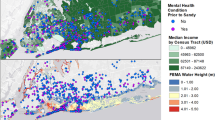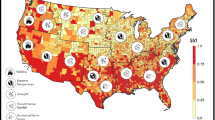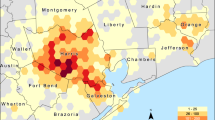Abstract
Purpose of Review
This review applies an environmental justice perspective to synthesize knowledge of flood-related health disparities across demographic groups in the USA. The primary aim is to examine differential impacts on physical and mental health outcomes while also assessing methodological considerations such as flood exposure metrics, baseline health metrics, and community engagement.
Recent Findings
In our review (n = 27), 65% and 72% of studies identified racial, ethnic, or socio-economic disparities in physical and mental health outcomes post-flooding, respectively. The majority of racial/ethnic disparities were based on Black race, while most socio-economic disparities were based on lower household income. Forty-two percent of studies lacked flood exposure metrics, but often identified disparities. Common flood exposure metrics included self-reported flooding, flood risk models, and satellite-based observations. Seventy percent of studies lacked baseline health measurements or suitable alternatives, and only 19% incorporated community engagement into their research design.
Summary
The literature consistently finds that both physical and mental health burdens following flooding are unequally shared across racial, ethnic, and socio-economic groups. These findings emphasize the need for disaster risk reduction policies that address underlying vulnerabilities to flooding, unequal exposure to flooding, and progressive funding for recovery efforts. Findings also underscore the importance of methodological enhancements to facilitate precise assessments of flood exposure and health outcomes.


Similar content being viewed by others
References
Papers of particular interest, published recently, have been highlighted as: • Of importance •• Of major importance
Collins TW, Grineski SE, Chakraborty J, Flores AB. Environmental injustice and Hurricane Harvey: a household-level study of socially disparate flood exposures in Greater Houston, Texas, USA. Environ Res. 2019;179:108772.
Chakraborty J, Collins TW, Grineski SE. Exploring the environmental justice implications of Hurricane Harvey flooding in Greater Houston. Texas Am J Public Health. 2019;109:244–50.
Lieberman-Cribbin W, Gillezeau C, Schwartz RM, Taioli E. Unequal social vulnerability to Hurricane Sandy flood exposure. J Expo Sci Environ Epidemiol. 2021;31:804–9.
Rufat S, Tate E, Burton CG, Maroof AS. Social vulnerability to floods: review of case studies and implications for measurement. Int J Disaster Risk Reduct. 2015;14:470–86.
Curtis A, Li B, Marx BD, Mills JW, Pine J. A multiple additive regression tree analysis of three exposure measures during Hurricane Katrina. Disasters. 2011;35:19–35.
Finch C, Emrich CT, Cutter SL. Disaster disparities and differential recovery in New Orleans. Popul Environ. 2010;31:179–202.
Griego AL, Flores AB, Collins TW, Grineski SE. Social vulnerability, disaster assistance, and recovery: a population-based study of Hurricane Harvey in Greater Houston. Texas Int J Disaster Risk Reduct. 2020;51:101766.
Min S-K, Zhang X, Zwiers FW, Hegerl GC. Human contribution to more-intense precipitation extremes. Nature. 2011;470:378–81.
Markonis Y, Papalexiou SM, Martinkova M, Hanel M. Assessment of water cycle intensification over land using a multisource global gridded precipitation dataset. J Geophys Res Atmospheres. 2019;124:11175–87.
Wahl T, Jain S, Bender J, Meyers SD, Luther ME. Increasing risk of compound flooding from storm surge and rainfall for major US cities. Nat Clim Change. 2015;5:1093–7.
Braswell AE, Leyk S, Connor DS, Uhl JH. Creeping disaster along the US coastline: understanding exposure to sea level rise and hurricanes through historical development Dias JM, editor. PLoS ONE. 2022;17:e0269741.
Qiang Y. Disparities of population exposed to flood hazards in the United States. J Environ Manage. 2019;232:295–304.
Wing OEJ, Lehman W, Bates PD, Sampson CC, Quinn N, Smith AM, et al. Inequitable patterns of US flood risk in the Anthropocene. Nat Clim Change. 2022;12:156–62.
Alderman K, Turner LR, Tong S. Floods and human health: a systematic review. Environ Int. 2012;47:37–47.
Zhong S, Yang L, Toloo S, Wang Z, Tong S, Sun X, et al. The long-term physical and psychological health impacts of flooding: a systematic mapping. Sci Total Environ. 2018;626:165–94.
Braveman P. Health disparities and health equity: concepts and measurement. Annu Rev Public Health. 2006;27:167–94.
Mohai P, Pellow D, Roberts JT. Environmental justice. Annu Rev Environ Resour. 2009;34:405–30.
Schlosberg D. Reconceiving environmental justice: global movements and political theories. Environ Polit. 2004;13:517–40.
Flores AB, Collins TW, Grineski SE, Griego AL, Mullen C, Nadybal SM, et al. Environmental injustice in the disaster cycle: Hurricane Harvey and the Texas Gulf Coast. Environ Justice. 2021;14:146–58.
Bullard RD, Wright B. Race, place, and environmental justice after Hurricane Katrina: sruggles to reclaim, rebuild, and revitalize New Orleans and the Gulf Coast. Boulder: Westview Press; 2009.
Ferraro PJ, Hanauer MM. Advances in measuring the environmental and social impacts of environmental programs. Annu Rev Environ Resour. 2014;39:495–517.
Angrist J, Pischke J-S. Parallel worlds: fixed effects, differences-in differences, and panel data. Most Harmless Econom. Princeton University Press; 2008. pp. 221–48.
Balazs CL, Morello-Frosch R. The Three Rs: how community-based participatory research strengthens the rigor, relevance, and reach of science. Environ Justice. 2013;6:9–16.
Jonkman SN, Kelman I. An analysis of the causes and circumstances of flood disaster deaths: an analysis of the causes and circumstances of flood disaster deaths. Disasters. 2005;29:75–97.
Brunkard J, Namulanda G, Ratard R. Hurricane Katrina Deaths, Louisiana, 2005. Disaster Med Public Health Prep. 2008;2:215–23.
Norris FH, Friedman MJ, Watson PJ, Byrne CM, Diaz E, Kaniasty K. 60,000 Disaster victims speak: Part I. An empirical review of the empirical literature, 1981–2001. Psychiatry Interpers Biol Process. 2002;65:207–39.
Chen A-C, Keith VM, Leong KJ, Airriess C, Li W, Chung K, et al. Hurricane Katrina: prior trauma, poverty and health among Vietnamese-American survivors. Int Nurs Rev. 2007;54:324–31.
Ruggiero KJ, Gros K, McCauley JL, Resnick HS, Morgan M, Kilpatrick DG, et al. Mental health outcomes among adults in Galveston and chambers counties after Hurricane Ike. Disaster Med Public Health Prep. 2012;6:26–32.
Ali JS, Farrell AS, Alexander AC, Forde DR, Stockton M, Ward KD. Race differences in depression vulnerability following Hurricane Katrina. Psychol Trauma Theory Res Pract Policy. 2017;9:317–24.
Rath B, Young EA, Harris A, Perrin K, Bronfin DR, Ratard R, et al. Adverse respiratory symptoms and environmental exposures among children and adolescents following Hurricane Katrina. Public Health Rep. 2011;126:853–60.
Jimenez AM, Collins TW, Grineski SE. Intra-ethnic disparities in respiratory health problems among hispanic residents impacted by a flood. J Asthma. 2013;50:463–71.
Barbara R, Jessica D, Alyson D, Keith P, Bronfin DR, Raoult R, et al. Adverse health outcomes after Hurricane Katrina among children and adolescents with chronic conditions. J Health Care Poor Underserved. 2007;18:405–17.
• Miranda ML, Callender R, Canales JM, Craft E, Ensor KB, Grossman M, et al. The Texas flood registry: a flexible tool for environmental and public health practitioners and researchers. J Expo Sci Environ Epidemiol. 2021;31:823–31. The collaboration for the Texas Flood Registry stands out as a well-executed partnership with non-academic community entities. This collaboration resulted in a robust database documenting flood exposure, home impacts, and associated health outcomes.
•• Ramesh B, Jagger MA, Zaitchik BF, Kolivras KN, Swarup S, Yang B, et al. Estimating changes in emergency department visits associated with floods caused by Tropical Storm Imelda using satellite observations and syndromic surveillance. Health Place. 2022;74:102757. This study’s innovative use of a controlled before-and-after design is crucial for robustly assessing the impact of flooding on health outcomes. The study’s approach, combining satellite observations with syndromic surveillance data, enhances the ability to characterize spatial and temporal patterns of adverse health outcomes.
Davis SA, Carpenter DM, Loughlin CE, Garcia N, Sleath B. Impact of Hurricane Matthew on a cohort of adolescents with asthma in North Carolina. Disaster Med Public Health Prep. 2023;17:e446.
Lenane Z, Peacock E, Joyce C, Frohlich ED, Re RN, Muntner P, et al. Association of post-traumatic stress disorder symptoms following Hurricane Katrina with incident cardiovascular disease events among older adults with hypertension. Am J Geriatr Psychiatry. 2019;27:310–21.
Xiao J, Zhang W, Huang M, Lu Y, Lawrence WR, Lin Z, et al. Increased risk of multiple pregnancy complications following large-scale power outages during Hurricane Sandy in New York State. Sci Total Environ. 2021;770:145359.
Seltzer N, Nobles J. Post-disaster fertility: Hurricane Katrina and the changing racial composition of New Orleans. Popul Environ. 2017;38:465–90.
• Quist AJL, Fliss MD, Wade TJ, Delamater PL, Richardson DB, Engel LS. Hurricane flooding and acute gastrointestinal illness in North Carolina. Sci Total Environ. 2022;809:151108. By incorporating time-series analysis, this research provides a detailed examination of the immediate effects of hurricanes on acute gastrointestinal illness, distinguishing outcomes between flooded and unflooded areas. Additionally, the study makes a valuable contribution by highlighting the often-overlooked impact of flood impacts on indigenous populations.
•• Ramesh B, Callender R, Zaitchik BF, Jagger MA, Swarup S, Gohlke JM. adverse health outcomes following Hurricane Harvey: a comparison of remotely-sensed and self-reported flood exposure estimates. GeoHealth. 7:e2022GH000710. Comprehensively evaluated flood-related outcomes in the aftermath of Hurricane Harvey using remotely sensed flood inundation measures comparing them with self-reported data from the Texas Flood Registry. This research sheds light on the congruence between satellite-derived flood estimates and individual-reported home flooding.
Oluyomi AO, Panthagani K, Sotelo J, Gu X, Armstrong G, Luo DN, et al. Houston hurricane Harvey health (Houston-3H) study: assessment of allergic symptoms and stress after hurricane Harvey flooding. Environ Health. 2021;20:9.
Flores AB, Collins TW, Grineski SE, Chakraborty J. Disparities in health effects and access to health care among Houston area residents after Hurricane Harvey. Public Health Rep. 2020;135:511–23.
Collins TW, Jimenez AM, Grineski SE. Hispanic health disparities after a flood disaster: results of a population-based survey of individuals experiencing home site damage in El Paso (Texas, USA). J Immigr Minor Health. 2013;15:415–26.
Flores AB, Collins TW, Grineski SE, Chakraborty J. Social vulnerability to Hurricane Harvey: unmet needs and adverse event experiences in Greater Houston. Texas Int J Disaster Risk Reduct. 2020;46:101521.
• Grineski SE, Flores AB, Collins TW, Chakraborty J. Hurricane Harvey and Greater Houston households: comparing pre-event preparedness with post-event health effects, event exposures, and recovery. Disasters. 2020;44:408–32. This research leverages a pre-/post-event sample of Greater Houston households. The inclusion of baseline data enhances the study’s robustness, enabling the examination of the relationship between preparedness, mitigation measures, and health outcomes. Findings suggest that pre-event mitigation is protective against adverse health outcomes, indicating a connection between household-level actions and health effects in the aftermath of a hurricane.
Horney JA, Stone KL, Karaye IM, Rauscher EA. Resident perception of environmental pollution in recreational areas flooded by Hurricane Harvey in Houston, Texas. J Environ Health. 83:8–16.
Chen L, Liu A. The incidence of posttraumatic stress disorder after floods: a meta-analysis. Disaster Med Public Health Prep. 2015;9:329–33.
DeSalvo KB, Hyre AD, Ompad DC, Menke A, Tynes LL, Muntner P. Symptoms of posttraumatic stress disorder in a New Orleans Workforce following Hurricane Katrina. J Urban Health. 2007;84:142–52.
Galea S, Tracy M, Norris F, Coffey SF. Financial and social circumstances and the incidence and course of PTSD in Mississippi during the first two years after Hurricane Katrina. J Trauma Stress. 2008;21:357–68.
• Lieberman-Cribbin W, Liu B, Schneider S, Schwartz R, Taioli E. Self-reported and FEMA flood exposure assessment after Hurricane Sandy: association with mental health outcomes Shaman J, editor. PLoS ONE. 2017;12:e0170965. The comparison between self-reported home flooding and high-water marks data from FEMA reveals substantial differences, emphasizing the predictive power of self-reported flooding for mental health outcomes.
Carl Y, Frias RL, Kurtevski S, González Copo T, Mustafa AR, Font CM, et al. The correlation of English language proficiency and indices of stress and anxiety in migrants from Puerto Rico after Hurricane Maria: a preliminary study. Disaster Med Public Health Prep. 2020;14:23–7.
Sastry N, VanLandingham M. One Year later: mental illness prevalence and disparities among New Orleans residents displaced by Hurricane Katrina. Am J Public Health. 2009;99:S725–31.
Ma C, Smith TE, Iversen RR. Mental illness prevalence and disparities among Hurricane Sandy survivors: a 2-year retrospective. Disaster Med Public Health Prep. 2021;15:579–88.
O’Fallon LR, Dearry A. Community-based participatory research as a tool to advance environmental health sciences. Environ Health Perspect. 2002;110:155–9.
Solar O, Irwin A. A conceptual framework for action on the social determinants of health [Internet]. World Health Organization; 2010 [cited 2023 Dec 13]. Available from: https://doi.org/10.13016/17cr-aqb9.
Ryan B, Johnston KA, Taylor M, McAndrew R. Community engagement for disaster preparedness: a systematic literature review. Int J Disaster Risk Reduct. 2020;49:101655.
Gaillard J, Peek L. Disaster-zone research needs a code of conduct. Nature. 2019;575:440–2.
O’Mara-Eves A, Brunton G, Oliver S, Kavanagh J, Jamal F, Thomas J. The effectiveness of community engagement in public health interventions for disadvantaged groups: a meta-analysis. BMC Public Health. 2015;15:129.
Davis LF, Ramírez-Andreotta MD. Participatory research for environmental justice: a critical interpretive synthesis. Environ Health Perspect. 2021;129:026001.
Hino M, Nance E. Five ways to ensure flood-risk research helps the most vulnerable. Nature. 2021;595:27–9.
Collins TW, Grineski SE, Morales DX. We need environmental health justice research and action for LGBTQ+ people. Am J Public Health. 2022;112:54–6.
Goldsmith L, Raditz V, Méndez M. Queer and present danger: understanding the disparate impacts of disasters on LGBTQ+ communities. Disasters. 2022;46:946–73.
Chakraborty J, Grineski SE, Collins TW. Hurricane Harvey and people with disabilities: disproportionate exposure to flooding in Houston. Texas Soc Sci Med. 2019;226:176–81.
Acknowledgements
We thank Robbie Parks, Cody Adams, Dave Love, and Molly Kile for the invitation to submit this review.
Funding
This work was partially supported by a seed grant from the Institute for Social Science Research at Arizona State University.
Author information
Authors and Affiliations
Contributions
A.B., J.A., and H.K. wrote the main manuscript text. Y.Y. prepared all figures and organized the manuscript into appropriate sections. All authors contributed to the literature search and reviewed the manuscript.
Corresponding author
Ethics declarations
Human and Animal Rights and Informed Consent
This article does not contain any studies with human or animal subjects performed by any of the authors.
Conflict of Interest
The authors declare no competing interests.
Additional information
Publisher's Note
Springer Nature remains neutral with regard to jurisdictional claims in published maps and institutional affiliations.
Rights and permissions
Springer Nature or its licensor (e.g. a society or other partner) holds exclusive rights to this article under a publishing agreement with the author(s) or other rightsholder(s); author self-archiving of the accepted manuscript version of this article is solely governed by the terms of such publishing agreement and applicable law.
About this article
Cite this article
Flores, A.B., Sullivan, J.A., Yu, Y. et al. Health Disparities in the Aftermath of Flood Events: A Review of Physical and Mental Health Outcomes with Methodological Considerations in the USA. Curr Envir Health Rpt (2024). https://doi.org/10.1007/s40572-024-00446-7
Accepted:
Published:
DOI: https://doi.org/10.1007/s40572-024-00446-7




